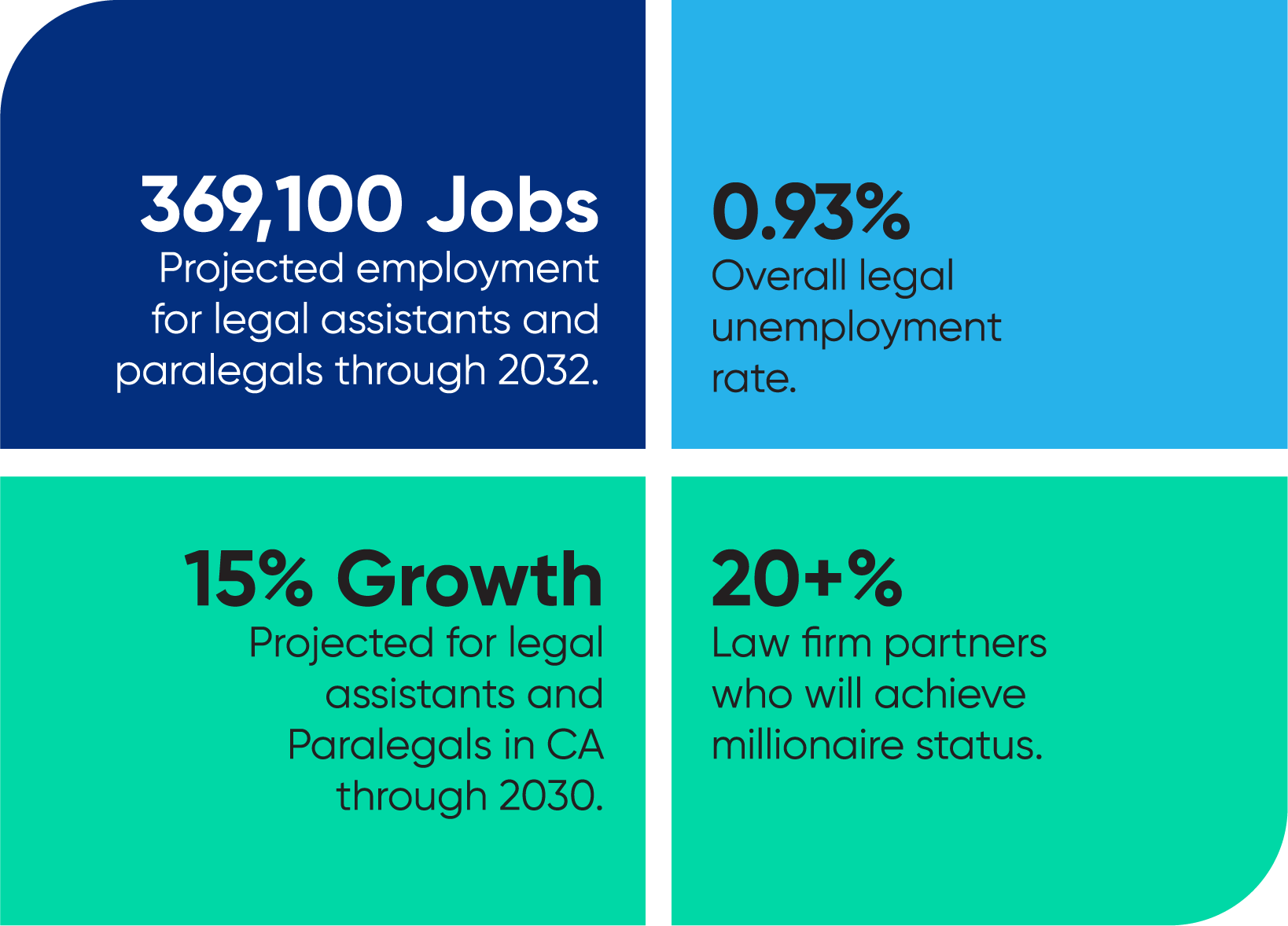
Jobs are like relationships. Everyone wonders about the choices other people make.
If you’re feeling like the law firm you’ve chosen is too big, too small, or too in-between, maybe it’s time to ask whether a different size law firm would be a better fit. After all, you’ll spend about 90,000 hours (about 10 and a half years) at work over a lifetime, so devoting 6 minutes now to making sure you’re working in an ideal environment is a good investment.
To help you understand the common differences among law firm sizes, this article maps out the pros and cons of large, midsize, and small firms that will help you zero in on an environment where you can thrive.
About the Size of It
Your gut will usually tell you if something’s not right. Whether you’re feeling limited, lost, overwhelmed, or uncertain, there may be something about your current job telling you it’s time to change venues.
That’s not necessarily bad news, considering that recent statistics suggest your decision to work in the legal industry already is a good choice:

These numbers show that, regardless of your role in the law office, your career success prospects look bright in the years ahead; making this a good time to channel your inner Goldilocks and find a law firm that feels like the right size for you.
So, what’ll it be: small, medium, or large?
The Big Deal About BigLaw
If you want to work on the world stage and reach the salary range’s top percentile, big law firms—aka BigLaw—are where you want to be. However, big rewards come with big demands. So, before you decide BigLaw is the place for you, make sure you understand what’s underneath the hood at big law firms.
The nation’s largest and most prestigious firms typically are characterized by having multiple offices spread across the globe with thousands of employees. A good example of a big law firm is Los Angeles-founded Latham & Watkins LLP, which operates in 14 countries and employs more than 3,500 lawyers.
Big firms outshine small firms in the same way Disneyland outshines a county fair. They have more space, more money, more attractions, and tend to be a destination rather than a stopover.
Legal professionals who join a big firm can expect to find extensive resources, a deep bench of talent, and name recognition. Big firms also attract marquee performers and provide sophisticated services smaller firms cannot.
Then there are the perks.
Beyond the upmarket furniture and high-rise views common to BigLaw offices, the advantages of working at a big firm go deep. They include:
- Top incomes
- Excellent training for young attorneys
- Challenging practice opportunities
- Smart, capable colleagues and mentors
- Industry prestige
- High-value networking and connections
On paper, big firms look like the stuff of dream jobs, but there are tradeoffs for working at the high end of the profession, such as:
- Long hours
- High pressure, competitive culture
- Strict dress code
- High billable quotas
- Limited client contact (for associate and junior roles)
- Challenging work-life balance
Another yellow flag at some big firms is a reporting structure that can be confusing. Whether you’re an associate attorney, legal assistant, or paralegal, you may find yourself working for multiple partners who rarely talk to each other. Nonetheless, they all are your bosses, which can breed confusion and frustration.
There is also intense pressure to give clients exactly what they want. The continuous demands of such exacting work can make it difficult for you to relax, even during time outside the office, making a work-life balance hard to achieve.
And don’t think that because a firm has its name emblazoned on the side of a skyscraper that every corner of the practice is a rainmaker.
In reality, large law firms that try to be everything to every client may have unproductive practice groups. The greatest expense for a law firm is salaries for lawyers and staff, so teams that have poor productivity drain away profitability and negatively affect the bottom line.
Go Big or Go Home?
Let’s say your career coaches and recruiters are hounding you to move into BigLaw. Should you listen to them?
It depends.
High-end casework constitutes the bulk of what large firms handle. So, if you prefer to work on high-profile, complex litigation and transactional legal work—or if celebrity clients and behemoth merger and acquisition matters are your thing—a big firm should be a good fit.
One more thing to tip the scales in favor of a big firm: Working in BigLaw looks good on a resume and can make you the most interesting person at a cocktail party.
Meet You in the Middle
Did we mention that big law firms are laying off employees due to overstaffing from the pandemic? Let that sink in before you set your heart on being part of the Am Law 100.
Some of the most active firms hiring today are midsize law firms, which can be categorized as firms with an average range of 16 to 350 attorneys on staff.
The “best of both worlds” qualities that characterize midsize law firms breed a good mix of clients, which can be attractive to some legal professionals. Midsize firms have the horsepower to take on larger clients that include large corporations from sectors such as real estate, litigation, finance, banking, and labor.
If matters in those areas appeal to you, a midsize firm is right up your alley.
Associate attorneys are winners at midsize firms, too, because they’re likely to have greater opportunity to work directly with clients than at a big law firm.
What about the money?
Midsize law firms fall short of the robust compensation for which big law firms are known. Overall, however, midsize firms offer better salaries than job seekers can expect at small law firms.
For example, a first-year attorney at the midsize Los Angeles-headquartered firm, Irell & Manella LLP, can expect to earn a $215,000 base salary.
Midsize firms may not grab a lot of headlines but that doesn’t keep them from being highly successful. In fact, Irell & Manella LLP has quietly secured verdicts and judgments worth more than $3.2 billion, including what is reportedly the largest patent judgement in history.
Midsize firms are on the move in the legal landscape and have led market growth for several successive quarters. A recent report shows midsize firms grew 2.8% in 2023 compared to Am Law 100, which saw its demand contract 0.6%.
That’s a figure that would be appealing to any career coach, and one that a job seeker who is seriously considering a midsize law firm should keep in mind.
Culture Club
The culture of midsize firms may be especially appealing because they tend to have less red tape than big firms, making them more agile. Legal professionals who work at midsize firms are also likely to have greater visibility to partners and colleagues compared to a big firm.
Other factors that contribute to the broad cultural and professional advantages at midsize firms include:
- Opportunity to become a skilled generalist
- Trial exposure
- Billable hour expectations that generally are more manageable than at large firms
- Clients may receive more attention from partners than associates
- Lawyers are more likely to know clients personally
- An hourly price advantage over large firms
But midsize firms have their drawbacks, one of which is a lack of resources that big firms typically possess. Likewise, midsize firms probably will not have the focus that is common among small firms.
So, who is a good fit for the midsize law firm?
If you want to do a little bit of everything among a wide variety of specialties, a midsize firm can offer a good way to build those skills. This can be a particularly good move during the first several years of a career, assuming the firm has good mentors.
Small Teams Can Do Big Things
If big firms and midsize firms still sound like too much for you, maybe it’s time to think small.
Practices that have 15 or fewer attorneys may be categorized as small law firms—or sometimes referred to as “boutique” firms. They often work in specialty areas or deal with complex subjects such as tax code or immigration law.
Boutique firms oftentimes are distinguished by offering a best-in-class specialized service or are staffed by legal professionals who speak niche languages. Additionally, small firms are often where lawyers find their first jobs.
There’s no shortage of benefits to working at a small law firm. Legal professionals across the board may be drawn to small firms because of:
- More flexible hours
- Better work-life balance
- Hands-on law practice experience
- Smaller bureaucracy
- More casual atmosphere
- Closer-knit staff
- More room for risk-taking and upward mobility
Because of their size, smaller firms also tend to have less in-house competition than big firms, which opens a door for legal professionals to be involved with more of the cases they want.
But what about salaries and long-term employment outlook?
Salary and Security
The salaries small firms offer will almost always be lower compared to salaries big firms pay, so there’s no surprise there. But if you’re exploring a future at a small firm, chances are that money isn’t your chief concern. What deserves closer scrutiny is job security.
Competitive threats from Internet-based legal services have shaken the legal industry and may be a problem for small firms. Likewise, artificial intelligence increasingly is infringing on tasks such as document review, legal research, and drafting contracts, which may make some legal professionals nervous.
Another Achilles heel for small firms is a tendency to have a short list of clients that generate the greatest amount of revenue. Losing only one or two of those clients could dramatically change the firm’s financial footing, so if you’re considering a small firm, it’s wise to find one with stable, long-term clients.
The work dynamics at small firms may also be problematic for some legal professionals, since the job tasks for legal assistants and paralegals may become blurred at smaller practices.
For example, at a small firm, a paralegal could be attached to administrative work that normally would be managed by a legal assistant in a midsize firm or BigLaw firm. This could be frustrating for the paralegal, especially if she or he enjoys focusing on doing more substantive legal work.
Downsize for the Right Size
If your career sweet spot is a client-centric role with a firm that is typically more agile and focused, a small law firm may be the place to call home.
That’s especially good news if you’re located in California, where 42% of law firms have between two and 10 attorneys. This large concentration of small law firms makes the Golden State an ideal place to find the perfect small law firm that fits you.
Fit for Life
Whether you long to be surrounded by the lore and mythology of BigLaw, or you want to be part of a specialized team that drives the boutique services of a small law firm, the best way to find your fit is to look for a firm that aligns with your career objectives and personal values.
You’ll know the right size firm when you feel it. It may not be the final destination for your career, but it very well may be what makes the journey enjoyable.
Get Started Today
Spend more time on billable client hours and less time tracking down conformed copies and proofs of service.

